Tracking the Global Recovery
Finance & Development, June 2012, Vol. 49, No. 2
M. Ayhan Kose, Prakash Loungani, and Marco E. Terrones
![]() Global outlook
Global outlook
![]() Progress with risks
Progress with risks
Most emerging markets are doing fine, but most advanced economies are not and things seem unlikely to change

THE world has experienced four global recessions since World War II—1975, 1982, 1991, and 2009. These were years in which the global citizen’s average income fell—in the jargon of economists, world per capita gross domestic product (GDP) declined—and there was a broad decline in various other measures of global economic activity. Each recession led to fears of economic apocalypse, but each time the global economy recovered in a year or two.
The global recession of 2009, which followed a financial market crisis caused by the failure of the investment banking firm Lehman Brothers the year before, was the deepest of the four recessions and the most synchronized across countries. Some worried that the world would relive the Great Depression of the 1930s. Luckily, and through often aggressive and unconventional policy actions, that did not come to pass. Since 2010, the global economy has been on a path of recovery, albeit a fragile one.
How different is the current global recovery from the earlier ones in the post–World War II period? How do prospects differ between advanced and emerging economies? And what are the risks to the global recovery?
On a slow track
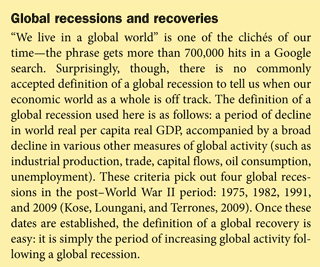
While arriving at a definition of a global recession takes some work (see box), defining a global recovery is easier. It is simply the period of increasing economic activity that follows a global recession.
The slow path of economic recovery since 2010 has been quite similar to the path, on average, in the aftermath of the three other global recessions (see Chart 1). In fact, if the projections of average global income—world per capita real GDP—are realized, recovery from the Great Recession, as it is often called, will have been faster than after the three previous global recessions.
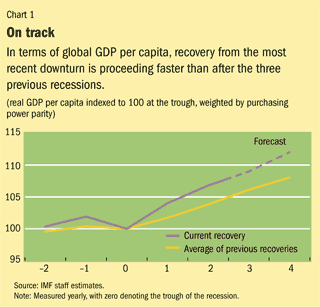
But the path of global income masks a very critical difference between advanced economies and emerging economies. The recovery in advanced economies has been very sluggish compared with past recoveries (see Chart 2, left panel). Average income in some of these economies has not yet rebounded to its pre-recession level and is not forecast to do so even by 2014.
The weakness in income growth is reflected, on the spending side, in both consumption and investment. Consumption has been held back as households return to safer debt-to-income levels (“deleverage”), and investment in structures has been weak in the aftermath of the housing boom in many advanced economies.
A faster pace
In sharp contrast to developments in advanced economies, average incomes in emerging economies are generally back on the fast track they were on before the Great Recession (see Chart 2, right panel). Income growth in these economies has already outpaced the growth seen during previous global recoveries, and is projected to continue to do so in coming years. The robust growth is widely shared among emerging economies. Notable exceptions are the emerging European economies, which are on a recovery track similar to that in advanced economies.
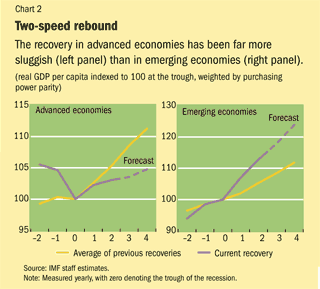
World trade collapsed dramatically during the global recession of 2009 and was one of the reasons the recession evoked fears of another Great Depression and a resort to protectionist measures by governments seeking to shield domestic industries from foreign competition. But world trade has rebounded, and again the pace is quicker in the emerging economies than in advanced ones (see Chart 3). Vertical specialization, in which a number of countries are involved in the production process of individual goods, may have restricted the use of traditional protectionist measures (see “Trade Policy: So Far So Good?” in this issue).
Equity markets have performed better on average during this recovery than in previous ones. This may be because corporations are increasingly operating globally. And global activity as a whole—thanks to emerging market economies—has recovered better than after previous recessions.
Waiting for the jobs train
Changes in unemployment generally lag changes in income. At the onset of a recession, as demand falls, companies cut back on overtime and make other adjustments before they let go of workers. As the recovery begins, companies generally wait to see whether it is durable before hiring workers again.
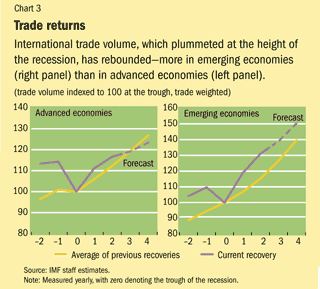
Despite this lag, over the course of a year, changes in incomes and unemployment tend to move together very closely. This relationship—known as Okun’s Law after it was described in an article written 50 years ago by the economist Arthur Okun (1962)—held up well during the global recession of 2009.
Over the course of the recession, the unemployment rate increased in advanced economies by about 2 percentage points between 2006 and 2009. Consistent with the weak income growth in these economies, unemployment has fallen very slowly during the recovery. Even by 2014, the unemployment rate in advanced economies is forecast to fall by less than 0.5 percentage points, that is, by less than a quarter of the increase during the recession (see Chart 4). In emerging economies, in contrast, unemployment rates on average barely budged during the recession and are forecast to fall by 2014.
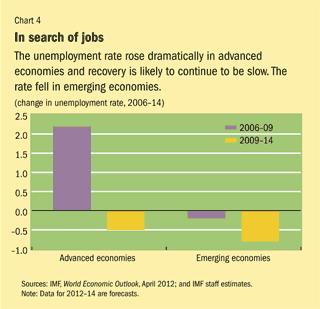
Among the advanced economies, the increase in unemployment varied a lot country by country during the recession. Three factors account for this variation: the extent of growth (or lack thereof) in incomes, structural bottlenecks, and the impact of macroeconomic and labor market policies. Structural factors may have played a supporting role in some countries, particularly where the collapse of the housing sector was a major reason for the drop in output. And the role of policies, particularly labor market policies such as worksharing, could be important in some specific cases, such as in explaining why Germany had a decline in unemployment. In Germany, employers receive subsidies to encourage them to retain workers but reduce their working hours and wages.
However, it was the growth factor that was by far the most important. Chart 5 shows that Spain, Ireland, Portugal, and the United States experienced the largest increases in the unemployment rate between 2007 and 2011. In Australia, Switzerland, Austria, Belgium, and Germany, however, unemployment barely increased—or even fell—over those years. These differences across countries in their unemployment experience can be explained almost perfectly by the changes in income growth in those countries. In other words, Okun’s Law holds quite well (Ball, Leigh, and Loungani, forthcoming). This predominant role of income growth in driving the labor market explains why unemployment declines are expected to be rather slow in advanced economies.
Is it ’92 all over again?
Although the world economy has recovered and another Great Depression has been staved off, the recovery remains subject to risks. Financial turmoil in Europe is an obvious risk.
In this respect, the current recession and recovery in advanced economies share some features with the recession and recovery in 1991–92. Both recessions are associated with a bust in credit and housing markets in key advanced economies. In 1991, there were busts in credit and asset markets in the United States, the United Kingdom, Japan, and the Scandinavian countries. The recent recession was associated with severe problems in credit and housing markets in the United States and a number of other advanced economies, including Ireland, Spain, and the United Kingdom.
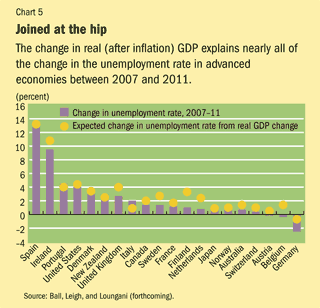
The path of income growth in advanced economies since 2010 is remarkably similar to that of the 1992 recovery. Both recoveries were slowed partly by challenges in Europe. The earlier recovery episode was shaped by downturns in many European economies during the 1992–93 crisis in the European Exchange Rate Mechanism, a precursor to the euro. Interest rates had to be raised during that period to defend the exchange rate arrangement, and several advanced European economies were forced to reduce their large fiscal deficits. This suppressed economic activity and further depressed credit and housing markets in the region.
Currently, high risk premiums on sovereign debt are inflicting similar or even worse damage to fiscal balances and growth. In both cases, the lack of a timely, credible, and coordinated policy strategy heightened the financial turmoil. There has been slow growth in domestic consumption and investment driven by the legacy of the financial crisis—households and companies with high levels of debt have scaled back their activities to reach safer levels of debt (see “Shedding Debt” in this issue).
Will oil shocks derail the recovery?
Another risk to the global recovery comes from oil shocks—possible disruptions in oil supplies and the associated spikes in oil prices. These developments played a role in the global recession of 1975.
Since that time, oil-importing countries have taken numerous steps to reduce their vulnerability to oil shocks. They have increased the number of sources from which they import oil, making them less vulnerable to disruptions from any one source, and have used other sources such as natural gas and renewables—for example, solar and wind—to substitute for oil. In both advanced and emerging economies, there have been increases in energy efficiency; the amount of energy needed to generate a dollar of income has fallen steadily. And central banks have become much better at establishing an anchor for inflation expectations by communicating that oil price increases do not alter longer-run inflation prospects. Hence the public in many countries is much less fearful that oil prices will have inflationary consequences than was the case in the past. Increased oil prices no longer feed a wage-price spiral, as they did in the 1970s.
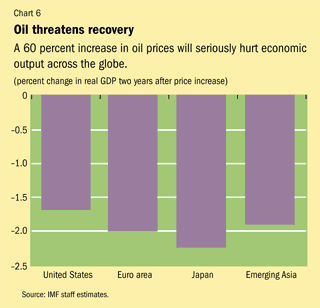
Nevertheless, while countries have built up some ability to withstand oil shocks, they remain vulnerable to severe supply disruptions or to the uncertainty induced by extreme oil price volatility. Estimates suggest that a 60 percent increase in the price of oil could reduce U.S. incomes by nearly 2 percent over a two-year period, with somewhat larger effects in Europe, Japan, and emerging economies in Asia (see Chart 6).
Fear of stalling
The ongoing global recovery is similar in various dimensions to previous episodes, but it also exhibits some significant differences. The divergence of fortunes of advanced and emerging market economies has been one of the most surprising outcomes of the current global recovery. Emerging markets have enjoyed their strongest rebound in activity and become the engine of world growth during this recovery. In contrast, the current recovery is predicted to be the weakest one of the postwar era for the advanced economies. The trajectory of recovery in advanced economies has exhibited some parallels with that of the recovery in 1992: both the current and 1992 recoveries were hampered by the financial market problems in advanced European economies. Failure to resolve these problems can stall the recovery and make already tepid job prospects in advanced economies worse. The threat of oil shocks looms as another risk factor for global economic prospects.■
M. Ayhan Kose is Assistant to the Director, Prakash Loungani is an Advisor, and Marco E. Terrones is Assistant to the Director, all in the IMF’s Research Department.
References
Ball, Laurence, Daniel Leigh, and Prakash Loungani, forthcoming, “Okun’s Law: Fit at 50?” IMF Working Paper (Washington: International Monetary Fund).
Kose, M. Ayhan, Prakash Loungani, and Marco E. Terrones, 2009, “Out of the Ballpark,” Finance & Development, Vol. 46, No. 2, pp. 25–28.
Okun, Arthur M., 1962, ‘‘Potential GNP: Its Measurement and Significance,” Proceedings of the Business and Economic Statistics Section of the American Statistical Association,
pp. 89–104.


